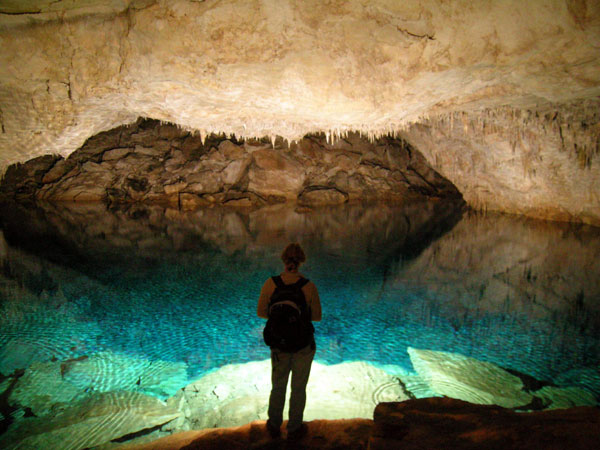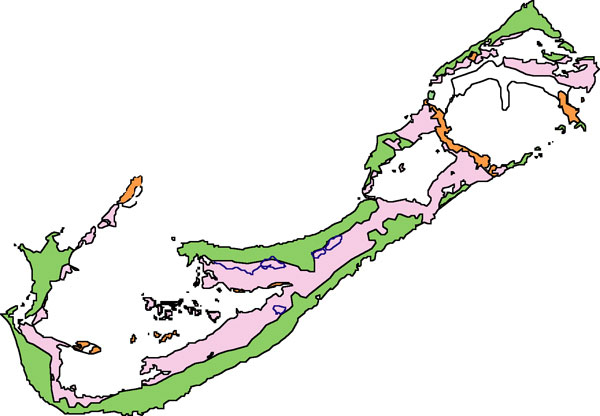NOAA On Origins Of Bermuda’s Marine Caves
The 150 inland limestone caves in Bermuda are believed to have formed during glacial periods when sea levels were 328 to 427 feet lower than they are now.
During these periods, the entire top of the Bermuda Pedestal was exposed so that the land mass was much larger and the fresh groundwater lens was much more extensive than that of present day Bermuda.
“As rainwater soaked through the soil, it picked up carbon dioxide to form a weak solution of carbonic acid,” said the US National Oceanic & Atmospheric Administration [NOAA] in a report on the Bermuda caves. “This acidic groundwater acted to dissolve the limestone, forming lateral voids.
“Over time, the dissolution process enlarged these voids to form liner conduits, caves, and underground lakes. Dripping water created massive stalactites and stalagmites in all parts of Bermuda caves.”
As post-glacial sea levels rose, the air-filled voids within the caves became flooded with sea water and cave formation ceased. Bermuda caves are today characterised by fissure entrances and large breakdown chambers that formed by collapse of roof rock when formerly flooded portions were exposed to air as glacial sea levels fell.
Water in Bermuda’s cave pools is brackish at the surface, but it reaches full marine salinity by a depth of several feet
The NOAA report said cave development in Bermuda was mainly confined to the oldest limestone layer known as the Walsingham formation where the rock is characterised by larger sinkholes, crevices and caves formed by dissolution.
The largest outcropping of the Walsingham formation and most of Bermuda’s known caves are located in the strip of land separating Castle Harbour and Harrington Sound.
Today, the largest known caves in Bermuda are submerged systems up to one mile long. Although surface water in inland cave pools is brackish, the water becomes fully marine at depths of several feet or more. Cave tides lag behind ocean tides by asm much as two-and-a-half hours and are reduced in amplitude.
Simplified geological map of Bermuda showing surface outcrops of the Walsingham limestone
Although all currently known caves in Bermuda are located inland, the existence of offshore, deep-water caves in Bermuda is strongly suggested by geological as well as biological evidence. During glacial low sea stands, subterranean drainage would have been channeled along the contact horizon between soluble limestone and underlying volcanic rock forming large caves that would now be submerged at depths of 328 feet or more.
“Bermuda’s underwater caves are inhabited by an exceptionally rich and diverse, blind and colorless, native marine fauna, consisting primarily of crustaceans,” said the NOAA report. “More that 80 new species have been described from Bermuda caves since the early 1980s.
“Many of these species are primitive, relics of an earlier time, showing pronounced morphological, physiological, and behavioral adaptations to the subterranean environment that suggests they have been living in caves or similar habitats for many millions of years.
The unoque crustacean Mictocaris halope inhabits several sea water caves in Bermuda
“However, all presently known caves in Bermuda were completely dry just 18,000 years ago when Ice Age sea levels were at least 328 feet lower than today. Also, a number of cave species are still only rarely encountered.”
It seems likely a suitable sub sea level, cave-like habitat must have provided refuge during periods of lower sea level and probably still exists today as the primary habitat for many of Bermuda’s rarer cave species said NOAA, pointing out that during periods of Pleistocene glaciations the land mass and rainwater catchment area of Bermuda would have been about 13 times larger than it is today, resulting in greatly increased water catchment and runoff through caves to the ocean.
NOAA says the marine caves in Bermuda and elsewhere are among the earth’s last largely unexplored frontiers of undiscovered animal life, some of which it calls “living fossils” from earlier ages.
– Photos courtesy of NOAA
Read More About
Category: All, Environment




